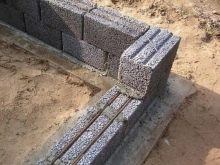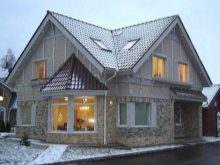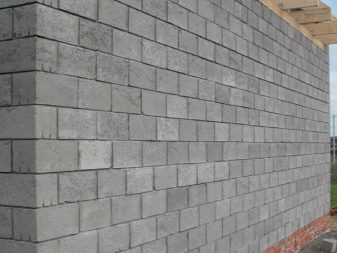Standard sizes of expanded clay concrete blocks

Today, such material as expanded clay concrete is widespread. This is due to its attractive characteristics, which have long been appreciated by construction professionals. Our article is devoted to a wide range of sizes of this material.
Peculiarities
The demand for piece materials for construction is not surprising. These designs are both affordable and superior in performance. Products made of expanded clay concrete have long been recognized as one of the best options for construction work.
But in order to build a long-serving, stably operated building, it is imperative to understand the dimensions of the structures themselves. It is important to understand that the brands of products do not indicate their size (as novice builders sometimes mistakenly believe), since they are set by completely different key parameters - frost resistance and mechanical strength.



Types and weight of material
Expanded clay blocks are divided into wall (width from 15 cm) and partition (this indicator is less than 15 cm) varieties. Wall products are used in load-bearing walls, partition walls are needed in order to form a box.
In both groups, full-bodied and hollow subgroups are distinguished, differing:
- thermal conductivity;
- mass;
- acoustic characteristics.


The dimensions of the expanded clay concrete blocks are clearly described in GOST 6133, published in 1999. For real construction, a large number of size groups are required, so in practice you can find a variety of solutions. Not to mention the fact that all factories are willing to take on individual orders with special requirements. Fully comply with the provisions of the standard, for example, products measuring 39x19x18.8 cm (although there are other formats). The rounding of these figures in catalogs and advertising information created the myth of a lightweight aggregate concrete block with a size of 39x19x19 cm.
In reality, all dimensions must be strictly adhered to, there are only clearly prescribed maximum deviations from the established linear dimensions of the blocks. The developers of the standard did not make such a decision in vain. They summarized the long experience of building houses in various cases and came to the conclusion that it is these values that are more practical than other options. So, in principle, there are no expanded clay concrete blocks that meet the standard, but at the same time have dimensions of 390x190x190 mm. This is just a clever marketing ploy, calculated on the consumer's inattention.

Partition structures can be tapered or oblong.
Their standard dimensions are presented in four size groups (with a slight deviation):
- 40x10x20 cm;
- 20x10x20 cm;
- 39x9x18.8 cm;
- 39x8x18.8 cm.
The seemingly too small thickness of the block in no way affects the insulation and protection from extraneous sounds. In terms of weight, a standard claydite concrete hollow block has a mass of 14.7 kg.
Again, we are talking about a product with sides (in mm):
- 390;
- 190;
- 188.



A masonry of 7 bricks has a comparable size. The weight of the hollow brick is 2 kg 600 g. The total weight of the brickwork will be 18 kg 200 g, that is, 3.5 kg more. If we talk about a full-bodied expanded clay concrete block of the same standard size, then its mass will be 16 kg 900 g. A brick configuration comparable in size will be 7.6 kg heavier.
The mass of slotted expanded clay concrete products with dimensions of 390x190x188 mm is 16 kg 200 g - 18 kg 800 g. If the thickness of full-bodied partition blocks made of expanded clay concrete is 0.09 m, then the mass of such a structure reaches 11 kg 700 g.
The choice of such overall parameters is not accidental: the blocks must ensure high-speed construction. The most common option - 190x188x390 mm, was selected using a very simple technique. The standard thickness of a layer of cement and sand mortar in most cases ranges from 10 to 15 mm. In this case, the typical wall thickness when laying in one brick is 20 cm.If you add the thicknesses of the expanded clay block and mortar, you get the same 20 cm.

If 190x188x390 mm is the most widely used standard size of expanded clay concrete, then the 230x188x390 mm option, on the contrary, is the least used in construction. This format of expanded clay blocks is produced by few factories. 390 mm is a masonry of 1.5 bricks with the addition of mortar.
Dimensions of expanded clay products for internal partitions and walls of houses (buildings) is 90x188x390 mm. Along with this option, there is another - 120x188x390 mm. Since interior partitions in houses and interior non-bearing partitions made of expanded clay concrete do not survive any mechanical stress, with the exception of their own weight, they are made 9 cm thick. Internal partitions are laid out from semi-blocks.


Size range
There are several widespread in the Russian Federation (fixed in GOST or provided for by TU) dimensions of building blocks for personal, residential and industrial construction:
- 120x188x390 mm;
- 190x188x390 mm;
- 190x188x190 mm;
- 288x190x188 mm;
- 390x188x90 mm;
- 400x100x200 mm;
- 200x100x200 mm;
- 390x188x80 mm;
- 230x188x390 mm (extremely rare version of the product).


The expanded clay block of standard dimensions is good not only for use, but also for transportation and storage. However, there are situations when non-standard material may be required during construction. The solution to this problem can be the order of an individual order. According to it, manufacturers can make claydite-concrete block products for various categories and objects of the construction industry, produced in accordance with technical specifications. By the way, the standards in Russia regulate not only the general linear values of the blocks themselves, but also the dimensions of the through holes, which must be strictly 150x130 mm.
Sometimes products from expanded clay concrete with dimensions of 300x200x200 mm are on sale, these are the same standard modules, but reduced in length by 100 mm. For products manufactured according to technical conditions, a larger deviation is allowed than for those prescribed in GOST. This deviation can reach 10 or even 20 mm. But the manufacturer is obliged to justify such a decision with technological and practical considerations.


The current state standard indicates the following dimensional grid of expanded clay concrete blocks:
- 288x288x138;
- 288x138x138;
- 390x190x188;
- 190x190x188;
- 90x190x188;
- 590x90x188;
- 390x190x188;
- 190x90x188 mm.

Permissible deviations
According to the instructions in section 5.2. GOST 6133-99 "Concrete wall stones", permissible deviations between the real and nominal dimensions of expanded clay concrete blocks can be:
- for length and width - 3 mm down and up;
- for height - 4 mm down and up;
- for the thickness of the walls and partitions - ± 3 mm;
- for deviations of the ribs (any) from a straight line - a maximum of 0.3 cm;
- for deviations of edges from flatness - up to 0.3 cm;
- for deviations of side faces and ends from perpendiculars - up to a maximum of 0.2 cm.
To control the linear parameters of blocks made of expanded clay concrete, only measuring instruments with a systematic error of no more than 0.1 cm should be used.
For this purpose, the following can be used:
- a ruler corresponding to GOST 427;
- vernier caliper that meets the standards of GOST 166;
- elbow, corresponding to the instructions of GOST 3749.


It is supposed to measure the length and width along the mutually opposed edges of the support planes. To measure the thickness, they are guided by the central parts of the faces located on the side and at the ends. All subtotals of measurements are assessed separately.
To determine the thickness of the outer walls, the measurement is carried out with a caliper of an established sample at a depth of 1-1.5 cm.Determining how far the edges deviate from the ideal right angle, take into account the largest final figure; longitudinal grooves of expanded clay concrete blocks can be placed at least 2 cm from the side surfaces.
In the following video, you will learn more about blocks based on expanded clay.













The comment was sent successfully.